Data centers and other applications are pushing changes in long-haul and short-haul fibers.
Fiber optics connects the world, carrying calls and data. With bandwidth demand growing, manufacturers are working to up transmission rates, cut costs and otherwise improve product performance. However, achieving these goals may require changing long- and short-haul fiber, while at the same time overcoming manufacturing-related challenges.
Long-haul fiber runs between cities and across oceans, and short-haul (or interconnect) fiber typically spans less than 500 m. Demands for both are being driven, in part, by megasized data centers, according to Robert Lingle Jr., director of systems and technology strategy at OFS. The Norcross, Ga.-based company is a leading designer and manufacturer of optical fiber, as well as associated cables and connectivity.
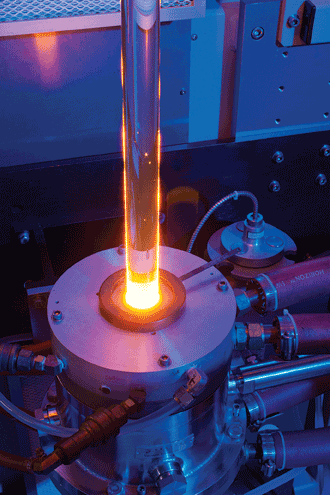
Drawing glass is the initial step in fiber optics manufacturing. Photo courtesy of AFL.
“In the past, major metropolitan areas determined where you needed long-haul fiber placed. Now, where these data centers are built is becoming a huge factor,” Lingle said.
It’s the many terabits, or thousands of gigabits, traveling to and from data centers that are influencing where long-haul fiber is being installed. There’s another effect, too: Moving that much data around demands higher transmission rates, so the industry will be transitioning to 400-Gb/s data links over the next few years. That’s significantly faster than 10 Gb/s, an important point given that telecom market analysis firm Infonetics Research found that more than half the installed links operated at that speed in 2009. Hitting the higher data rates on long-haul fiber is made harder as operators want to send signals up to 2000 km without regeneration.
Part of the solution involves changes to the fiber. In the past, standard single-mode fiber used in long-haul communication had an effective light-confining core of about 80 sq µm, or a core diameter of about 10 µm. Now fibers are being manufactured with cores of 125 sq µm for terrestrial use and up to 150 sq µm for submarine fibers, with the latter having a 14-µm diameter.
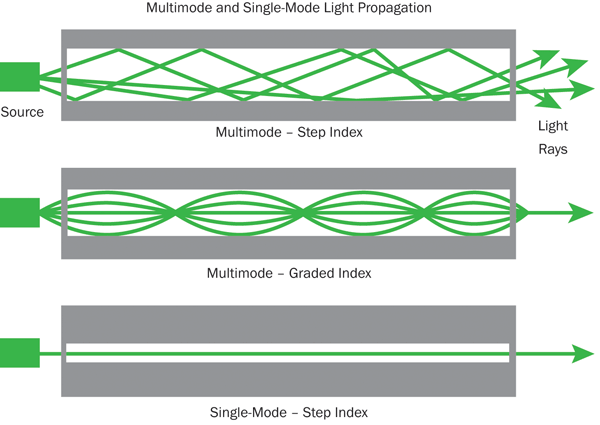
Light traveling through step-index and graded-index multimode optical fiber does so in modes in addition to the fundamental, which is how it travels through single-mode optical fibers. Multimode fiber cores tend to be larger in diameter than single-mode fiber cores. Multimode is used for short-haul interconnection links, while single-mode is used for long-haul links. Photo courtesy of ProLabs.
These large-area fibers are just recently being deployed, Lingle said. “That’s to optimize the cables for coherent modulation formats, which is what makes 100 Gb/s and 400 Gb/s possible.”
Larger-diameter fibers are better for coherent modulation because they offer a higher nonlinear threshold and a higher dispersion coefficient, according to Giacomo Losio, technical sales manager at transceiver maker ProLabs of Minneapolis. But data will not always be traveling down new larger-core fiber.
“We have to be realistic. Fiber is already in the system. Nobody is going to rip that out,” Losio said. “You have to make sure that what you’re testing covers the situation you find in the field.”
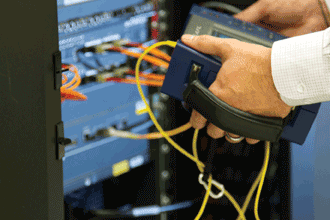
Testing optical fiber connections in a data center. Photo courtesy of AFL.
In multimode fiber, cores are typically 50 µm in diameter. Unlike smaller-diameter single-mode fiber, these large cores convey light in other transmission modes, in addition to the fundamental. Multimode fibers make up the bulk of what goes into data centers.
“Within short-reach applications, like data centers, multimode is about 80 percent of all the glass you’re going to find,” said Paul Kolesar, engineering fellow in fiber optics systems engineering at cablemaker CommScope of Hickory, N.C.
This isn’t because the fiber itself is cheaper, according to Kolesar. What multimode fiber enables is less costly overall links, partly because of less stringent alignment tolerances and partly because of the ability to use inexpensive optical transceivers based on vertical-cavity surface-emitting lasers (VCSELs). These lasers operate at 850 nm, and multimode fiber is optimized for that wavelength.
That split between single- and multimode fiber in data centers could be changing, however. Data centers covering areas in the million-plus square feet or more are popping up in the U.S., India and China. These massive conglomerations of servers and storage require high-speed fiber optic links that could be several kilometers long, so these spans may necessitate the use of single-mode fiber.
Getting the needed performance out of the single-mode fiber found in data centers is not likely to present a problem. For data-center multimode fiber, on the other hand, the looming challenge is one of speed.
There will be a shift in the bulk of the market in the near future from 10 to 25, 40 and 100 Gb/s. In the next decade, transmission rates will move to 400 Gb/s, with 1600 Gb/s perhaps the next step.
Meeting those faster data rates may involve wavelength division multiplexing, in which multiple wavelengths travel down the fiber with each carrying data. Networking giant Cisco’s BiDi product, announced in November 2013, does just that, sending 850- and 900-nm light through the fiber. Each wavelength conveys data at 20 Gb/s. Moving beyond two to four or more channels will require modifying the multimode fiber itself.

Wavelength division multiplexing ups fiber transmission rates by using multiple wavelengths that each carry data. Implementing this for multimode fiber may require material changes. MUX = multiplexer, DEMUX = demultiplexer. Photo courtesy of Paul Kolesar, CommScope.
“You can only tune the current material system to peak at one wavelength. The idea is to change the design so that it will serve multiple wavelengths at high bandwidth simultaneously,” Kolesar said.
OFS is among those actively working to develop a wavelength division multiplexing multimode fiber, Lingle said. One reason to do so is to keep multimode fiber links at less than half the cost per link of single-mode fiber. The fiber dopants used to pull off transmission of multiple wavelengths for years in single-mode fiber could enable multimode fiber to do similar multiplexing.
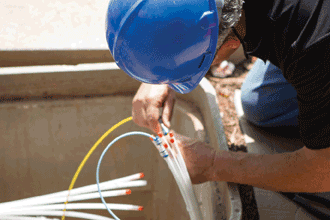
Installing optical fiber via blowing air, a process that can be used in data centers and other building-enclosed locations. Photo courtesy of AFL.
Multiwavelength multimode fiber might be designed to accommodate four channels, each about 20 or 30 nm apart. The spacing will be such as to make possible the use of low-cost transceivers. To preserve backward compatibility, the likely wavelengths will start at 850 and then move upward out to about 1000 nm.
The exact configuration will be hammered out by the industry, with the final arrangement selected to balance the demands on fiber, connectors and transceivers.
Transceiver maker Avago Technologies of San Jose, Calif., is one company working to optimize how to operate multimode fiber at multiple wavelengths. The solution might involve modifications to the fiber that would necessitate manufacturing changes, with the idea of devising a better overall solution by moving away from an 850-nm optimized fiber, according to Mitchell Fields, senior director of marketing and strategy of the firm’s fiber optics division.
“Maybe we want to shift or broaden that optimization to improve the overall bandwidth that can be supported by VCSELs, such as to longer wavelengths,” Fields said.
The other hot topic in the industry, he added, involves fibers with multiple cores, as that represents another way to increase bandwidth. Issues here involve the fiber connectors and how to splice the fiber. The challenge is that these multiple fibers have cores about the size of a human hair. All have to be connected, eventually and economically, to a transceiver.
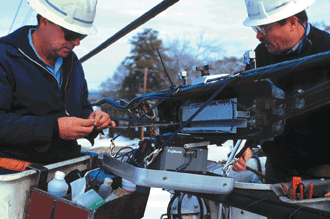
Field splicing optical fibers is now significantly faster than it was 10 years ago, thanks to the use of photonic technologies. Photo courtesy of AFL.
Various photonic technologies make the job of connecting fiber easier. For instance, when fiber is deployed, most of the connections in the field are done using a fusion splicer, said Brad Hendrix, global specialty market manager at fiber optic cable and accessory manufacturer AFL of Spartanburg, S.C. What used to take minutes a decade or so ago is now done in seven seconds, with a protective sleeve applied in 14. Video cameras, pattern matching and image processing make this possible. Similar technology could handle the chore for ribbon fiber also.
Another innovation that can help ease the bandwidth crunch in data centers is the use of what AFL calls MicroCore fiber. Since data-center fiber will be inside a building and encased in a tray, it doesn’t need a bulky protective covering. Eliminating that covering reduces the size of a cable as much as 75 percent and cuts installation cost. Approaches like this can be combined with wavelength multiplexing to create a solution to growing bandwidth demands.
“The user can install more fiber in smaller spaces and put many wavelengths on each one of these fibers,” Hendrix said.
As for the future, fiber is finding its way to and even inside the home. Corning is now selling a consumer fiber product intended to satisfy high-bandwidth needs, such as might arise from playing or editing high-definition video or audio, said Brandon Groff, multimode fiber product line manager at the Corning, N.Y.-based fiber maker. Whereas an electrical connection might allow this over a few feet, fiber can do so at a distance of up to 60 feet.
This is an example of the interaction between growing processing power, a consequence of Moore’s law; bandwidth increasing three times faster than computing power (Gilder’s law); and the value of
a network going up with square of the number of users (Metcalfe’s law). These three factors force manufacturing innovations that up fiber performance and cut costs. Such improvements and the impact of the three laws power a long-running trend that looks to continue, according to Groff.
“As the bandwidth demand grows, there’s demand for fiber deeper in the network,” he said.